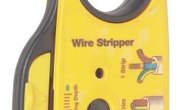Starter motors spin up like mad when you turn your boat's key and press the starter button; that small motor has to motivate that large outboard to turn over and run. The only problem is when your outboard doesn't start, and you're left wondering if the problem is the starter itself or just the starter button. You can test the starter with a 12-volt battery boat so that know exactly where you stand.
Items you will need
1/4-inch open-end wrench
5/8-inch open-end wrench
Soft-jaw bench vise
Voltmeter
Clamp-type amp multimeter
2 jumper cables, 12 gauge AWG
Vibration tachometer
Remove the nut from the starter motor terminal with a 1/4-inch open-end wrench. Lift the red starter cable from the starter motor terminal. Remove the starter from the motor, using 5/8-inch open-end wrench. Move the starter to a soft-jaw bench vise.
Connect a voltmeter across the terminals of a 12-volt DC battery to monitor the battery's voltage. Connect the positive battery cable to the electrical terminal from which you removed the starter cable. Clamp a clamp-type amp multimeter around the positive cable.
Connect one end of an oversize jumper cable -- 12-gauge AWG or larger -- to the negative post of of the battery. Hold a vibration tachometer against the outside of the starter motor.
Connect the jumper from the negative battery post to the starter casing. The starter will begin to run.
Disconnect the negative jumper wire from the starter casing as soon as the starter achieves the correct speed and is within the correct amperage readings. Replace the starter motor if it fails to reach its proper cranking rpm without exceeding the amperage rating for the engine model.
Warnings
- Conduct this test in a well-ventilated area, lest a spark from one of the jumper cables ignites gasoline vapors in the area as you connect the negative cable to the starter's casing.
Tips
- As the test starts, check the meters.The voltmeter must not drop below 12 volts DC when you connect the negative jumper cable to the starter. If it does so, it needs replacement.
- Watch the amp clamp, the vibration tachometer and the voltmeder's readings while testing. The correct speeds and amperages are as follows: for 9.9 horsepower four-stroke, 9.9 horsepower two-stroke and 15 horsepower two-stroke motors, the starter must rotate between 7000 rpm and 9200 rpm while drawing no more than 7 amps. For four-stroke motors of between 18 and 35 horsepower, and two-stroke motors of between 25 and 35 horsepower, the starter must rotate between 6500 rpm and 7500 rpm while drawing no more than 30 amps. For larger motors, the starter must rotate between 5700 rpm and 8000 rpm while drawing no more than 32 amps.
References
- "Johnson Repair Manual - 2.5 to 250 HP Models, 2002-2007"; Seloc Marine; 2007
Tips
- As the test starts, check the meters.The voltmeter must not drop below 12 volts DC when you connect the negative jumper cable to the starter. If it does so, it needs replacement.
- Watch the amp clamp, the vibration tachometer and the voltmeder's readings while testing. The correct speeds and amperages are as follows: for 9.9 horsepower four-stroke, 9.9 horsepower two-stroke and 15 horsepower two-stroke motors, the starter must rotate between 7000 rpm and 9200 rpm while drawing no more than 7 amps. For four-stroke motors of between 18 and 35 horsepower, and two-stroke motors of between 25 and 35 horsepower, the starter must rotate between 6500 rpm and 7500 rpm while drawing no more than 30 amps. For larger motors, the starter must rotate between 5700 rpm and 8000 rpm while drawing no more than 32 amps.
Warnings
- Conduct this test in a well-ventilated area, lest a spark from one of the jumper cables ignites gasoline vapors in the area as you connect the negative cable to the starter's casing.
Writer Bio
Will Charpentier is a writer who specializes in boating and maritime subjects. A retired ship captain, Charpentier holds a doctorate in applied ocean science and engineering. He is also a certified marine technician and the author of a popular text on writing local history.



